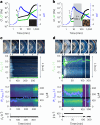Forging out-of-equilibrium supramolecular gels
- PMID: 39664796
- PMCID: PMC11628395
- DOI: 10.1038/s44160-024-00623-4
Forging out-of-equilibrium supramolecular gels
Abstract
The design of supramolecular hydrogels comprising aligned domains is important for the fabrication of biomimetic materials and applications in optoelectronics. One way to access such materials is by the self-assembly of small molecules into long fibres, which can be aligned using an external stimulus. Out-of-equilibrium supramolecular gels can also be designed, where pre-programmed changes of state can be induced by the addition of chemical fuels. Here we exploit these dynamic properties to form materials with aligned domains through a 'forging' approach: an external force is used to rearrange the underlying network from random to aligned fibres as the system undergoes a pre-programmed gel-to-sol-to-gel transition. We show that we can predictably organize the supramolecular fibres, leading to controllable formation of materials with aligned domains through a high degree of temporal control.
Keywords: Biomaterials; Self-assembly; Soft materials; Supramolecular polymers.
© The Author(s) 2024.
Conflict of interest statement
Competing interestsThe authors declare no competing interests.
Figures




References
-
- van Esch, J. H., Klajn, R. & Otto, S. Chemical systems out of equilibrium. Chem. Soc. Rev.46, 5474–5475 (2017). - PubMed
-
- della Sala, F., Neri, S., Maiti, S., Chen, J. L. Y. & Prins, L. J. Transient self-assembly of molecular nanostructures driven by chemical fuels. Curr. Opin. Biotechnol.46, 27–33 (2017). - PubMed
-
- Ragazzon, G. & Prins, L. J. Energy consumption in chemical fuel-driven self-assembly. Nat. Nanotechnol.13, 882–889 (2018). - PubMed
-
- Rieß, B., Grötsch, R. K. & Boekhoven, J. The design of dissipative molecular assemblies driven by chemical reaction cycles. Chem6, 552–578 (2020).
-
- Sharko, A., Livitz, D., De Piccoli, S., Bishop, K. J. M. & Hermans, T. M. Insights into chemically fueled supramolecular polymers. Chem. Rev.122, 11759–11777 (2022). - PubMed
Grants and funding
LinkOut - more resources
Full Text Sources
